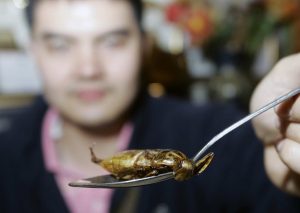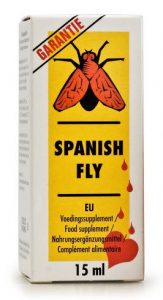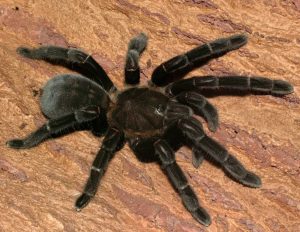 Many of our best drugs are derived from natural sources. Most people will first think of the curative properties of plants such as willows (acetylsalicylic acid, Aspirin) and Pacific Yew (paclitaxel, a cancer-fighting agent). These plants produce chemicals which help with everything from communication and mating to defense and self-medication.
Many of our best drugs are derived from natural sources. Most people will first think of the curative properties of plants such as willows (acetylsalicylic acid, Aspirin) and Pacific Yew (paclitaxel, a cancer-fighting agent). These plants produce chemicals which help with everything from communication and mating to defense and self-medication.
However, there is a greater plethora of useful chemicals to be had. Relatively speaking, plants comprise a very small portion of the Earth’s biomass. Meanwhile, invertebrates, which are all animals lacking a spine from sea worms to insects, represent over 95% of all animal species on Earth. There are more species of beetles alone there are species of plants- talk about a taxon of opportunity!
 Insects especially have a long history of medical use. Since Hippocrates, Spanish Flies (a misnamed member of the beetle family Meloidae) have been used to treat an assortment of conditions. The chemical responsible is Cantharidin, the same stuff that gives Meloidae the common name “Blister Beetles”. Spanish Fly is still used today- though it should be noted that a 30 mg dose is fatal to humans. Bees also have a long history of medicinal use, with nothing in the hive going to waste. Honey’s hyperosmotic properties make it an excellent wound dressing, while Propolis (an antibacterial, super sticky substance that bees use as a glue and sealant) is refined into a tincture and used to treat everything from sore throats to joint pain. Even the bees themselves are used- “Bee Venom Therapy” is growing in popularity as a treatment for arthritis (though still lacks substantial scientific study).
Insects especially have a long history of medical use. Since Hippocrates, Spanish Flies (a misnamed member of the beetle family Meloidae) have been used to treat an assortment of conditions. The chemical responsible is Cantharidin, the same stuff that gives Meloidae the common name “Blister Beetles”. Spanish Fly is still used today- though it should be noted that a 30 mg dose is fatal to humans. Bees also have a long history of medicinal use, with nothing in the hive going to waste. Honey’s hyperosmotic properties make it an excellent wound dressing, while Propolis (an antibacterial, super sticky substance that bees use as a glue and sealant) is refined into a tincture and used to treat everything from sore throats to joint pain. Even the bees themselves are used- “Bee Venom Therapy” is growing in popularity as a treatment for arthritis (though still lacks substantial scientific study).
Today, more research than ever is going into invertebrate-derived drugs. Predatory invertebrates often paralyze their prey before eating them, and these toxins are being investigated and developed into a new generation of pain killers. Many of these painkillers act on the voltage-gated sodium channel NaV1.7, which is involved with the ability to sense pain. Professor Glen King from the University of Queensland has investigated the use of centipede venom to treat chronic pain and has so far found great potential in their strength and lack of adverse side effects. This month he published another study investigating spider venom, and what chemicals it contains that act on NaV1.7; after assaying 205 types of spider venom, his team discovered 7 new peptides which inhibit the ion channel. There is more than one ion channel involved in pain sensory, of course, so it important that we investigate other invertebrate toxins. Recent advancements in electrophysiology with technologies such as the Ion Channel Reader will help more scientists in studying how these toxins modulate voltage-gated ion channels. Cone snails, famous for their beautiful shells and deadly sting, have lead to the potent ω-conotoxin MVIIA which acts on the channel Cav2.2.
spider venom, and what chemicals it contains that act on NaV1.7; after assaying 205 types of spider venom, his team discovered 7 new peptides which inhibit the ion channel. There is more than one ion channel involved in pain sensory, of course, so it important that we investigate other invertebrate toxins. Recent advancements in electrophysiology with technologies such as the Ion Channel Reader will help more scientists in studying how these toxins modulate voltage-gated ion channels. Cone snails, famous for their beautiful shells and deadly sting, have lead to the potent ω-conotoxin MVIIA which acts on the channel Cav2.2.
Traditionally we have looked to microbes— to bacteria and yeast, from protists to fungi— to find useful chemicals and therapeutic compounds. Invertebrates are the most diverse group outside of these microorganisms, and yet they remain a largely untapped pool for many useful compounds and chemicals. From pheromones to toxins, they have evolved these chemicals to excel in the competitive bug-eat-bug world. Why did cone snails evolve such a potent toxin? What defensive-chemical were they competing with, and could we use that in turn to improve human life? We need more scientists looking under rocks and in the deep seas for creepy crawlies! From simple sponges to fantastical flies, there is an enormous opportunity here for drug discovery. Maybe someone will finally discover the cure for the common cold, thanks to a jellyfish.
Do you know of any invertebrate chemicals worth investigating for drug discovery? Let us know in the comments below!


